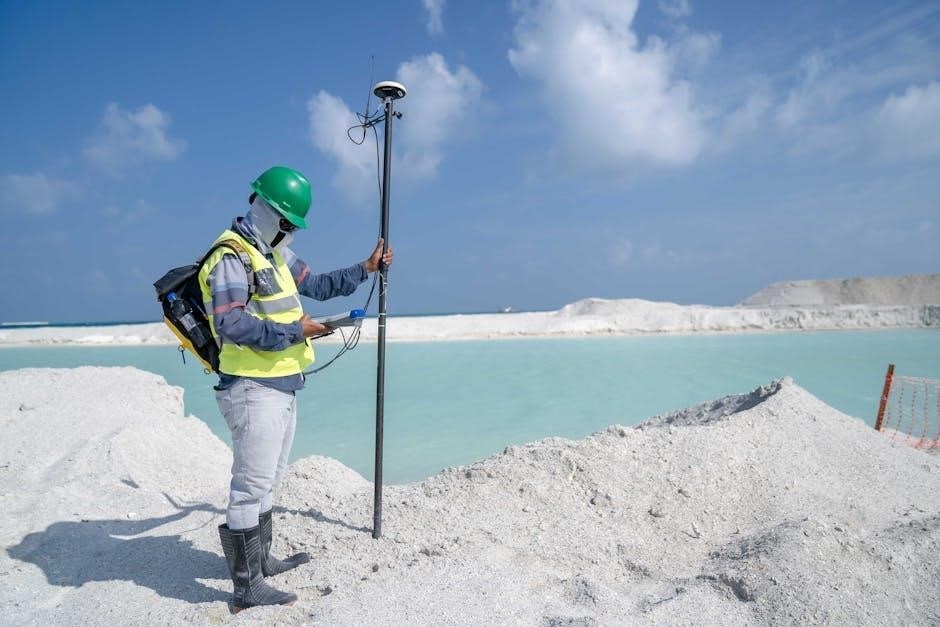
This manual serves as a comprehensive guide for surveyors, detailing historical context, essential tools, modern technologies, and methodologies. It provides insights into best practices and real-world applications, ensuring accuracy and efficiency in surveying tasks while adhering to legal and ethical standards.
Overview of the Importance of Surveying
Surveying is fundamental to determining land boundaries, ensuring property rights, and guiding urban development. It plays a crucial role in infrastructure planning, environmental monitoring, and legal disputes. By providing precise measurements and spatial data, surveying supports sustainable development and informed decision-making. Its applications span from construction to conservation, making it indispensable for balancing human progress with environmental preservation. Accurate surveying ensures safety, legality, and efficiency in various projects, underpinning the foundation of modern society;
Structure and Purpose of the Manual
The Surveyor Reference Manual is organized to provide a comprehensive understanding of surveying principles, tools, and methodologies. Its purpose is to serve as an essential guide for surveyors, offering detailed insights into historical context, modern technologies, legal frameworks, and best practices. The manual is structured to ensure clarity and accessibility, allowing professionals to quickly locate relevant information. It aims to support surveyors in performing their tasks accurately, ethically, and efficiently, while staying informed about industry advancements and standards.

History and Evolution of Surveying
Surveying traces its origins to ancient civilizations, with early techniques used in Egypt and Babylon for land measurement and construction. Over centuries, methods evolved, incorporating new tools and technologies, adapting to societal needs and advancements in science and engineering.
Early Surveying Techniques
Early surveying techniques were rudimentary, relying on basic tools like ropes, stakes, and measuring rods. Ancient civilizations, such as the Egyptians and Romans, used these tools to plan cities and manage agricultural lands. The Groma, a Roman tool, was used for aligning roads and buildings. In Egypt, the Nilometer measured river levels for land assessment. These early methods, though simple, laid the groundwork for modern surveying by emphasizing accuracy and practicality in land measurement and resource management.
Modern Advancements in Surveying Technology
Modern surveying has embraced cutting-edge technologies like GPS, laser scanning, and drones, enhancing precision and efficiency. GPS allows real-time data collection, while laser-based tools enable highly accurate 3D mapping. Drones equipped with photogrammetry software capture aerial data swiftly. Artificial intelligence aids in data analysis, automating tasks like boundary detection. Cloud-based platforms facilitate collaboration, enabling teams to share and process data globally. These advancements have revolutionized the field, reducing errors and speeding up project delivery while maintaining high standards of accuracy and reliability in surveying operations.

Essential Tools and Equipment for Surveyors
Surveyors rely on tools like theodolites, GPS devices, laser levels, and specialized software for accurate measurements and data analysis, ensuring precision in mapping and boundary determination;
Traditional Surveying Instruments
Traditional surveying instruments include theodolites, levels, tape measures, and compasses. These tools enable precise measurements of angles, distances, and elevations. Theodolites measure horizontal and vertical angles, while levels ensure accurate height measurements. Tape measures provide distance calculations, and compasses determine direction. These instruments have been foundational in surveying, offering reliability for boundary and topographic assessments. Their use has evolved with technology but remains essential for understanding fundamental surveying principles and methodologies.
Modern GPS and Laser-Based Tools
Modern surveying employs GPS and laser-based tools for enhanced accuracy and efficiency. GPS systems provide precise location data using satellite networks, enabling real-time positioning. Laser tools, such as total stations and laser levels, offer high-precision measurements for distance and alignment. These technologies streamline data collection, reduce errors, and improve project timelines. Integrating GPS and laser tools has revolutionized surveying, allowing for complex tasks like 3D mapping and large-scale construction planning with unprecedented accuracy and speed, making them indispensable in contemporary surveying practices.
Software for Data Collection and Analysis
Advanced software solutions play a pivotal role in modern surveying, enabling efficient data collection, processing, and analysis. These tools integrate seamlessly with GPS and laser-based instruments, offering features like real-time data synchronization and 3D modeling. Surveying software enhances accuracy and streamlines workflows, allowing for the creation of detailed topographic maps and precise boundary calculations. Additionally, these programs facilitate data interpretation, enabling surveyors to generate comprehensive reports and visualizations. By leveraging specialized software, professionals can achieve higher productivity and deliver more accurate results in diverse surveying projects.

Surveying Methodologies
Surveying methodologies encompass various techniques such as geodetic, topographic, and boundary surveys, each tailored to specific objectives like land mapping, construction planning, and property demarcation, ensuring precise results.
Geodetic Surveying
Geodetic surveying focuses on measuring large-scale features of the Earth’s surface, utilizing advanced tools like GPS and terrestrial networks. It establishes precise reference systems for mapping and spatial applications, ensuring high accuracy over vast areas. This methodology is vital for projects requiring a high level of positional precision, such as national mapping, infrastructure development, and geophysical research. By combining satellite data with ground-based measurements, geodetic surveying provides the foundational framework for modern mapping and navigation systems, enabling accurate spatial referencing and analysis.
Topographic Surveying
Topographic surveying maps the physical features of land, including natural terrain and human-made structures. It involves measuring elevations, slopes, and contours to create detailed 3D models. This method is essential for urban planning, construction projects, and environmental assessments. By using tools like GPS, laser scanners, and aerial photography, surveyors gather precise data to visualize and analyze landscapes. The results are often used to guide development, ensure safety, and manage natural resources effectively, making it a cornerstone of modern surveying practices.
Land Use and Boundary Surveying
Land use and boundary surveying focuses on defining property lines and determining how land is utilized. It ensures legal compliance, resolves disputes, and supports urban planning. Surveyors use GPS, maps, and legal records to establish accurate boundaries. This method is vital for zoning adherence, environmental assessments, and property transactions. By combining historical data with modern tools, surveyors provide clear definitions of land ownership and usage, aiding in sustainable development and resource management while maintaining legal and regulatory standards.

Legal and Regulatory Framework
The legal and regulatory framework governs surveying practices, ensuring compliance with property laws, environmental regulations, and ethical standards. It emphasizes accuracy, transparency, and accountability to protect stakeholders and public interests.
Property Laws and Regulations
Property laws and regulations establish the legal framework for surveying, ensuring accurate boundary determinations and ownership verification. These laws govern land use, zoning, and rights of way, preventing disputes and ensuring compliance. Surveyors must adhere to statutes regarding property titles, easements, and encumbrances, while also respecting environmental and cultural preservation regulations. Compliance with these laws is crucial for maintaining public trust and avoiding legal repercussions. Understanding local, state, and federal regulations is essential for surveyors to conduct their work ethically and effectively.
Environmental and Zoning Considerations
Surveyors must navigate environmental and zoning regulations to ensure projects align with ecological and community standards. This involves assessing land use, wetland areas, and protected habitats to prevent harm. Compliance with zoning laws dictates permissible land use, ensuring developments meet safety and community standards. Collaboration with environmental agencies and the use of advanced tools help identify risks and propose sustainable solutions. Balancing development with conservation protects ecosystems while supporting infrastructure growth, ensuring ethical practices and minimizing legal or environmental repercussions.

Data Collection and Analysis
This section covers field data collection methods, processing techniques, and quality control measures. It emphasizes the role of modern tools like GPS and software for precise analysis.
Field Data Collection Techniques
Field data collection involves precise measurement and recording of spatial information using tools like theodolites, GPS, and laser scanners. Surveyors employ techniques such as leveling, triangulation, and trilateration to ensure accuracy. Modern methods incorporate drones and mobile mapping systems for efficient data gathering. Best practices include thorough planning, repeated measurements, and real-time data validation to minimize errors. Proper documentation and adherence to standardized protocols are crucial for maintaining data integrity and reliability in surveying projects.
Processing and Interpreting Survey Data
Processing survey data involves converting raw measurements into usable formats, such as coordinates or maps. Surveyors use specialized software to adjust for errors, ensuring accuracy. Interpretation includes analyzing data to identify patterns, boundaries, or topographic features. Techniques like least squares adjustment and spatial analysis enhance precision. The results are visualized through maps, reports, or 3D models, providing clear insights for decision-making. Proper data management and verification are critical to maintain reliability and meet project requirements.
Quality Control in Data Management
Quality control in survey data management ensures accuracy and reliability by verifying measurements and processes. Surveyors implement checks to identify and correct errors, using tools like cross-validation and audits. Data integrity is maintained through standardized protocols and documentation. Precision is enhanced by calibrating instruments and adhering to predefined tolerances. Regular reviews and validations ensure compliance with professional standards, safeguarding the integrity of survey outcomes. Effective quality control minimizes discrepancies, ensuring trustworthy results for decision-making and project execution.

Integration with Modern Technology
Modern technology enhances surveying through drones, AI, and cloud platforms, improving efficiency, accuracy, and collaboration. These tools enable real-time data processing and seamless project management.
Use of Drones in Surveying
Drones have revolutionized surveying by enabling rapid and accurate data collection. Equipped with high-resolution cameras and sensors, they capture detailed aerial imagery, which is processed into precise 3D models. This technology enhances efficiency, reduces manual labor, and improves safety in challenging terrains. Drones also minimize costs and time compared to traditional methods. Their ability to cover large areas quickly makes them ideal for applications like land mapping, construction monitoring, and environmental assessments, ensuring scalable and reliable results for modern surveying needs.
Artificial Intelligence in Survey Analysis
Artificial Intelligence (AI) enhances survey analysis by automating data processing and improving accuracy. AI algorithms can quickly interpret large datasets, identify patterns, and generate insights, reducing manual effort. Machine learning models optimize survey design and predict outcomes, ensuring more reliable results. AI also aids in real-time data analysis, enabling faster decision-making. By integrating AI, surveyors can streamline workflows, minimize errors, and deliver precise, actionable data, making it a transformative tool in modern surveying practices.
Cloud-Based Platforms for Collaboration
Cloud-based platforms revolutionize surveying by enabling real-time collaboration and data sharing. These tools allow teams to access projects from anywhere, fostering seamless communication. Features like version control and centralized storage ensure data accuracy and reduce duplication. Cloud solutions enhance security with encryption and controlled access. They also support scalability, accommodating teams of all sizes. By integrating with tools like GIS and CAD, cloud platforms streamline workflows, making them indispensable for modern surveying projects that require efficiency and precision.

Best Practices for Surveyors
Adhering to ethical standards, ensuring accuracy, and staying updated with modern tools are essential. Continuous learning and clear communication foster trust and professionalism in surveying endeavors.
Professional Ethics and Standards
Professional ethics and standards form the foundation of trustworthy surveying practices. Surveyors must uphold honesty, integrity, and transparency in all interactions. Adhering to established codes of conduct ensures accuracy and fairness. Confidentiality of client information is paramount, and avoiding conflicts of interest is essential. Ethical decision-making fosters credibility and maintains public trust. Continuous adherence to these principles is vital for the profession’s integrity and societal reliance on surveying outcomes. These standards guide surveyors in delivering reliable and unbiased results consistently.
Safety Protocols in the Field
Safety protocols are critical for surveyors to ensure well-being while working in various environments. Personal protective equipment, such as hard hats and reflective clothing, must be worn. Surveyors should assess site-specific risks, including uneven terrain or traffic, and maintain situational awareness. Proper use of tools and equipment is essential to prevent accidents. Communication devices should always be accessible in case of emergencies. Adhering to these protocols minimizes hazards and ensures safe, efficient data collection. Prioritizing safety protects both the surveyor and the integrity of the work being performed.
Continuous Professional Development
Continuous professional development is essential for surveyors to stay updated with emerging technologies and methodologies. Engaging in workshops, webinars, and certifications ensures proficiency in modern tools like GPS and laser-based equipment. Active participation in industry forums and peer discussions fosters collaboration and knowledge sharing. Regular training also helps surveyors adapt to evolving legal and ethical standards. By committing to lifelong learning, professionals enhance their skills, deliver accurate results, and maintain credibility in their field, ultimately benefiting both clients and the broader surveying community.

Case Studies and Practical Applications
This section explores real-world applications of surveying techniques, showcasing their use in urban development, infrastructure projects, and environmental monitoring. Practical examples illustrate key surveying principles and methodologies.
Urban Development Projects
Surveyors play a crucial role in urban development by ensuring accurate land mapping and property boundaries. They enable efficient planning and execution of construction projects, from roadways to high-rise buildings. By providing precise data, surveyors help developers comply with zoning laws and environmental regulations. Modern tools like GPS and drones enhance their ability to collect and analyze data quickly. This ensures projects are completed on time and within budget, while maintaining safety and sustainability standards. Their work is essential for creating functional and aesthetically pleasing urban landscapes.
Infrastructure and Transportation Surveys
Surveyors are integral to infrastructure and transportation projects, ensuring precise measurements for roads, bridges, and railways. They use tools like GPS, LiDAR, and traditional theodolites to map topography and align structures. Accurate data ensures safety, cost-efficiency, and compliance with engineering standards. Surveyors also monitor construction progress and verify completed work. Their role is critical in maintaining infrastructure integrity, supporting economic growth, and enhancing public safety. Advanced technologies enable real-time data collection, improving project outcomes and long-term sustainability.
Environmental Monitoring and Conservation
Surveyors play a vital role in environmental monitoring and conservation by mapping ecosystems, tracking land changes, and assessing impacts of human activities. Using tools like GPS, GIS, and drones, they collect data on topography, water resources, and biodiversity. This information aids in creating protected areas, restoring habitats, and combating illegal activities like deforestation. Surveyors also monitor climate change effects, ensuring sustainable practices in land use. Their work is essential for balancing development with environmental preservation, supporting global efforts to protect natural resources for future generations.

Future Trends in Surveying
Emerging technologies like AI, drones, and cloud platforms are reshaping surveying, enabling real-time data processing, enhanced accuracy, and sustainable practices, ensuring surveyors meet future demands efficiently.
Emerging Technologies and Innovations
The integration of advanced technologies is revolutionizing surveying, with drones enabling rapid aerial data collection and AI enhancing data analysis. Cloud-based platforms improve collaboration, while innovations like real-time kinematic GPS and laser scanning boost accuracy. These tools not only streamline processes but also enable surveyors to tackle complex projects with greater efficiency. As technology evolves, the surveying profession continues to adopt cutting-edge solutions, ensuring precise and sustainable outcomes for future developments.
Globalization of Surveying Practices
Globalization has led to the standardization of surveying practices worldwide, fostering collaboration and consistency across borders. Advanced technologies and shared methodologies enable surveyors to work seamlessly on international projects, ensuring adherence to global standards. This uniformity enhances project outcomes and facilitates the exchange of knowledge and resources, driving the profession forward on a global scale while addressing diverse regional requirements effectively.
Sustainability in Surveying Operations
Sustainability is a growing focus in surveying, with practices aimed at minimizing environmental impact. Tools like drones and satellite imaging reduce the need for physical site visits, lowering carbon footprints. Energy-efficient equipment and eco-friendly data collection methods are increasingly adopted. Surveyors also play a role in environmental monitoring and conservation by providing accurate data for sustainable development projects, ensuring that operations align with global environmental goals and promote long-term ecological balance while maintaining professional standards.
The Surveyor Reference Manual underscores the evolution of surveying, blending tradition with modern technology. It equips professionals with essential tools, methodologies, and ethical standards, ensuring accuracy and sustainability in diverse applications.
The Surveyor Reference Manual provides a comprehensive overview of surveying principles, tools, and methodologies. It covers historical evolution, from traditional techniques to modern technologies like GPS and drones. Key concepts include geodetic, topographic, and boundary surveying, along with legal frameworks and data analysis. The manual emphasizes professional ethics, safety protocols, and continuous development. It also explores emerging trends such as AI integration and cloud-based collaboration, ensuring surveyors remain equipped for future challenges. By blending theory and practice, the manual serves as an indispensable resource for professionals in the field.
Final Thoughts on the Evolution of Surveying
The evolution of surveying reflects a seamless blend of tradition and innovation, from manual measurements to advanced technologies like GPS, drones, and AI; This progression underscores the field’s adaptability, ensuring accuracy and efficiency in modern projects; As surveying embraces sustainability and ethical practices, it remains vital for urban development, infrastructure, and environmental conservation. The Surveyor Reference Manual captures this journey, serving as a bridge between historical techniques and future advancements, empowering professionals to meet global challenges with precision and responsibility.